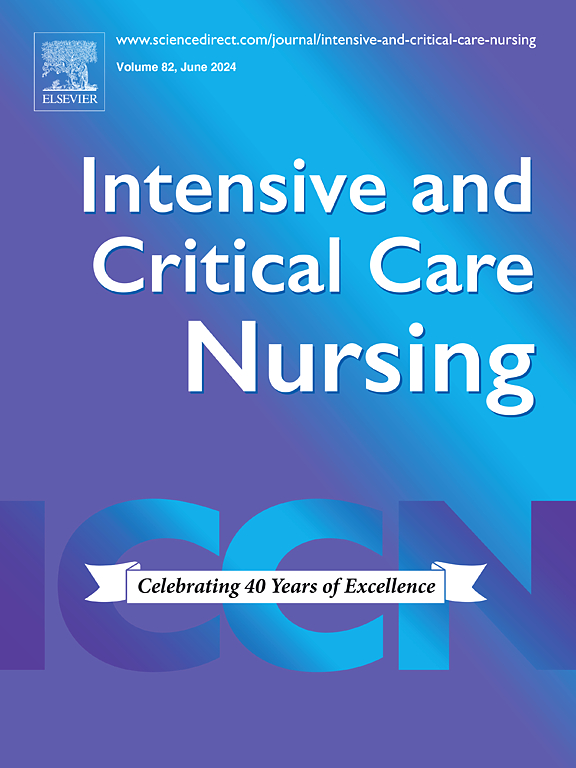Comparative effectiveness of noninvasive ventilation interfaces in critically ill adults: A systematic review and Bayesian network meta-analysis
IF 4.7
2区 医学
Q1 NURSING
引用次数: 0
Abstract
Objectives
To systematically review the effectiveness of different types of interfaces in the treatment of critically ill patients with respiratory failure requiring NIV.
Methods
Parallel randomized controlled trials (RCTs) were identified through a search conducted in the MEDLINE, CENTRAL, EMBASE, and LILACS databases. Review Manager 5 software was used for direct comparisons. Risk ratios (RR) with 95% confidence interval (CI) or credible interval (CrI) were used for dichotomous outcomes. Continuous outcomes were reported as mean differences (MD) with 95% CIs. MetaInsight software was used for conducting network meta-analysis (NMA) with Bayesian random-effects models.
Results
A systematic search was conducted on August 4, 2022, and last updated on November 6, 2024. Seven studies were included, involving 406 patients, and four different interfaces (helmet, oronasal, nasal, and full-face) were utilized. Helmet may reduce intubation rate, ICU and hospital length of stay, when compared to oronasal mask (RR 0.38 [95% CrI 0.2 to 0.75], RR −3.34 [95% CrI −6.94 to 0.49] and RR −2.4 [95% CrI −6.23 to 1.62]), with low certainty of the evidence. Furthermore, the evidence is very uncertain regarding the effects of the helmet on reducing serious adverse events, with very low certainty of the evidence. The evidence remains uncertain for the outcomes of in-hospital mortality, serious adverse events, mild and moderate adverse events, comfort, and tolerance.
Conclusions
The helmet interface probably reduces the length of stay and intubation rates when used for non-invasive ventilation in critically ill patients with respiratory failure. However, the findings should be interpreted with caution as it generates from RCT with small sample sizes.
Implications for clinical practice
This network meta-analysis offers comparative evidence to guide clinical decision-making regarding interface selection during noninvasive ventilation, with the potential to enhance treatment effectiveness and patient outcomes.
危重成人无创通气接口的比较有效性:系统回顾和贝叶斯网络荟萃分析
目的系统评价不同类型接口在重症呼吸衰竭患者无创通气治疗中的效果。方法通过检索MEDLINE、CENTRAL、EMBASE和LILACS数据库,筛选平行随机对照试验(rct)。使用Review Manager 5软件进行直接比较。风险比(RR)与95%可信区间(CI)或可信区间(CrI)用于二分类结果。连续结果报告为95% ci的平均差异(MD)。采用MetaInsight软件对贝叶斯随机效应模型进行网络元分析(NMA)。结果系统检索于2022年8月4日进行,最后一次更新于2024年11月6日。纳入7项研究,涉及406例患者,使用4种不同的界面(头盔、口鼻、鼻和全脸)。与口鼻口罩相比,头盔可减少插管率、ICU和住院时间(RR = 0.38 [95% CrI = 0.2 ~ 0.75], RR = 3.34 [95% CrI = 6.94 ~ 0.49], RR = 2.4 [95% CrI = 6.23 ~ 1.62]),证据的确定性较低。此外,关于头盔对减少严重不良事件的影响,证据非常不确定,证据的确定性非常低。关于住院死亡率、严重不良事件、轻度和中度不良事件、舒适度和耐受性的结果,证据仍然不确定。结论头盔接口可减少危重患者无创呼吸通气的住院时间和插管率。然而,研究结果应该谨慎解读,因为它是来自小样本量的随机对照试验。该网络荟萃分析为指导无创通气过程中接口选择的临床决策提供了比较证据,具有提高治疗效果和患者预后的潜力。
本文章由计算机程序翻译,如有差异,请以英文原文为准。
求助全文
约1分钟内获得全文
求助全文
来源期刊

Intensive and Critical Care Nursing
NURSING-
CiteScore
6.30
自引率
15.10%
发文量
144
审稿时长
57 days
期刊介绍:
The aims of Intensive and Critical Care Nursing are to promote excellence of care of critically ill patients by specialist nurses and their professional colleagues; to provide an international and interdisciplinary forum for the publication, dissemination and exchange of research findings, experience and ideas; to develop and enhance the knowledge, skills, attitudes and creative thinking essential to good critical care nursing practice. The journal publishes reviews, updates and feature articles in addition to original papers and significant preliminary communications. Articles may deal with any part of practice including relevant clinical, research, educational, psychological and technological aspects.
 求助内容:
求助内容: 应助结果提醒方式:
应助结果提醒方式:


